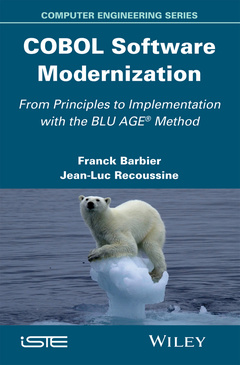COBOL Software Modernization From Principles to Implementation with the BLU AGE Method
Auteurs : Barbier Franck, Recoussine Jean-Luc

Nowadays, billions of lines of code are in the COBOL programming language. This book is an analysis, a diagnosis, a strategy, a MDD method and a tool to transform legacy COBOL into modernized applications that comply with Internet computing, Service-Oriented Architecture (SOA) and the Cloud. It serves as a blueprint for those in charge of finding solutions to this considerable challenge.
ACKNOWLEDGMENTS xi
ACRONYMS xiii
INTRODUCTION xvii
CHAPTER 1. SOFTWARE MODERNIZATION: A BUSINESS VISION 1
1.1. Software-based business 1
1.2. Information-driven business 2
1.2.1. Adaptation to business 4
1.3. The case of tourism industry 7
1.4. IT progress acceleration 11
1.5. Legacy world 13
1.5.1. Exiting the legacy world 15
1.5.2. Legacy world professionals 16
1.6. Conclusions 18
CHAPTER 2. SOFTWARE MODERNIZATION: TECHNICAL ENVIRONMENT 21
2.1. Legacy system 21
2.2. Modernization 22
2.2.1. Replacement 24
2.2.2. Migration 25
2.2.3. Modernization versus migration 27
2.2.4. The superiority of white-box modernization 29
2.3. Software engineering principles underpinning modernization 31
2.3.1. Re-engineering in action 33
2.3.2. Re-engineering challenges 36
2.4. Conclusions 37
CHAPTER 3. STATUS OF COBOL LEGACY APPLICATIONS 39
3.1. OLTP versus batch programs 41
3.2. Mainframes 42
3.3. Data-driven design 43
3.4. COBOL degeneration principle 44
3.5. COBOL pitfalls 46
3.6. Middleware for COBOL 47
3.7. Moving COBOL OLTP/batch programs to Java 49
3.8. COBOL is not a friend of Java, and vice versa 51
3.9. Spaghetti code 52
3.9.1. Spaghetti code sample 53
3.9.2. Code comprehension 56
3.10. No longer COBOL? 57
3.11. Conclusions 58
CHAPTER 4. SERVICE-ORIENTED ARCHITECTURE (SOA) 59
4.1. Software architecture versus information system urbanization 59
4.2. Software architecture evolution 60
4.3. COBOL own style of software architecture 61
4.4. The one-way road to SOA 64
4.5. Characterization of SOA 66
4.5.1. Preliminary note 66
4.5.2. From objects to components and services 66
4.5.3. Type versus instance 67
4.5.4. Distribution concerns 68
4.5.5. Functional grouping 68
4.5.6. Granularity 69
4.5.7. Technology-centrism 70
4.5.8. Composition at design time (… is definitely modeling) 72
4.5.9. Composition at runtime 77
4.6. Conclusions 78
CHAPTER 5. SOA IN ACTION 79
5.1. Service as materialized component 81
5.2. Service as Internet resource 85
5.2.1. Pay-per-use service 87
5.2.2. Free service 89
5.2.3. Data feed service 90
5.3. High-end SOA 93
5.4. SOA challenges 95
5.5. The Cloud 97
5.5.1. COBOL in the Cloud 98
5.5.2. Computing is just resource consumption 99
5.5.3. Cloud computing is also resource consumption, but… 101
5.5.4. Everything as a service 102
5.5.5. SOA in the Cloud 104
5.5.6. The cloud counterparts 105
5.6. Conclusions 106
CHAPTER 6. MODEL-DRIVEN DEVELOPMENT (MDD) 109
6.1. Why MDD? 110
6.2. Models, intuitively 111
6.3. Models, formally 112
6.4. Models as computerized objects 113
6.5. Model-based productivity 118
6.6. Openness through standards 118
6.6.1. Model-Driven Architecture (MDA) 120
6.7. Models and people 121
6.8. Metamodeling 123
6.8.1. Metamodeling, put simply 123
6.9. Model transformation 125
6.10. Model transformation by example 125
6.11. From contemplative to executable models 126
6.12. Model execution in action 127
6.13. Toward Domain-Specific Modeling Languages (DSMLs) 129
6.14. Conclusions 132
CHAPTER 7. MODEL-DRIVEN SOFTWARE MODERNIZATION 135
7.1. Reverse and forward engineering are indivisible components of modernization 137
7.2. Architecture-Driven Modernization (ADM) 138
7.3. ASTM and KDM at a glance 142
7.4. Variations on ASTM 146
7.5. From ASTM to KDM 148
7.6. Variations on KDM 149
7.7. Automation 153
7.8. Conclusions 153
CHAPTER 8. SOFTWARE MODERNIZATION METHOD AND TOOL 155
8.1. BLU AGE overview 156
8.2. The toolbox 158
8.2.1. BLU AGE format required for forward engineering 160
8.2.2. Reverse tooling 162
8.3. BLU AGE as an ADM- and MDA-compliant tool 170
8.4. Modernization workflow 173
8.4.1. Initialization 173
8.4.2. Realization 182
8.4.3. Validation and deployment 187
8.5. Conclusions 188
CHAPTER 9. CASE STUDY 191
9.1. Case study presentation 192
9.2. Legacy modernization in action 195
9.2.1. Creating modernization project 196
9.2.2. Better dealing with the legacy material 196
9.2.3. Strategy for modernizing screens 202
9.2.4. Strategy for modernizing data items 203
9.2.5. Creating forward project 204
9.2.6. Entity extraction 207
9.2.7. From screens to pages and UI components 209
9.3. Annotations 209
9.4. Pattern definition 211
9.4.1. Pattern for simple statements 211
9.4.2. Patterns for operation calls 213
9.4.3. Patterns for operation calls with arguments 214
9.4. Database exchange modernization 216
9.5. Transmodeling 219
9.6. Transmodeling complex functionalities 226
9.6.1. Transmodeling the “custCost” program 228
9.6.2. Modernizing “Add a new reservation” 233
9.7. Application generation and testing 234
9.8. Conclusions 235
BIBLIOGRAPHY 239
INDEX 243
Franck Barbier (www.FranckBarbier.com) is both at Netfective Technology as scientific consultant and full Professor in Computer Science at the university of Pau (France). He wrote more than 100 papers and books in French and English, for Hermes Science Publishing especially. He was Director of the CS Research Department of the university of Pau (LIUPPA) from 2000 to 2004; He was Deputy Head of the Information and Communication Technologies (ICT) sector at the French Research Agency, a.k.a. ANR (i.e., "French NSF") from 2009 to 2012. He is a recognized expert worldwide in model driven development.
Jean-Luc Recoussine is the general manager of the Blu Age Institute within Blu Age Corporation (a Netfective Technology subsidiary and USA company located in Plano, Texas, USA). Blu Age Institute is a training center for Blu Age products and MDD approach. He moved to the USA in 2011 after spending 6 years in the Blu Age Center of Casablanca (Morocco) where he was member of the founding team and in charge of setting up the Blu Age Support Center. He is an expert in model driven application transformation using Blu Age tools and the methodology.
Date de parution : 01-2015
Ouvrage de 282 p.
16.5x24.3 cm
Thème de COBOL Software Modernization :
Mots-clés :
acronyms; introduction; business vision; adaptation; case; tourism industry; legacy world; environment; technical; migration; superiority; whitebox; underpinning; principles; engineering; reengineering; action; legacy; status



